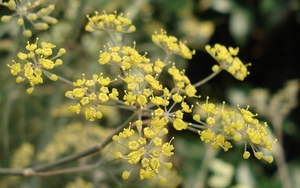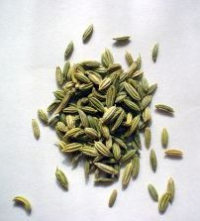Fennel Characteristics
(Fæniculum officinale)

Name Origin:
The old Latin name for fennel, Fæniculum is derived from the word for hay.
Natural Order:
Umbelliferæ
Growing Cycle:
Biennual or perennial herb
Origins:
It has spread much as civilization has particularly where Italians have colonized and may be found growing wild in many parts of the world near the sea coast and upon river banks. Learn more of the History of Fennel.
Height:
Fennel grows to 5-6 feet tall

Growth Habit:
The core of the fennel plant is similar in appearance to celery but more of a shape like an onion. The branches grow up the sides of this core into delicate, feathery branches like shown above.
Fennel Flowers:
Tiny, yellowish-green flowers in clusters on stalks.
How to Grow Fennel
(Seeds, sowing, cultivation, and harvesting)
Growing Fennel From Seeds

Seed is most viable when fresh but is known to have germinated after 4 or more years.
When growing fennel from seed, sow the seeds in nursery beds or where the plants are to remain. Makes drills 6 inches apart and plant fennel seeds no more than 1-3 inches deep.
In some climates, seeds are sown in late summer and in autumn for early crops the following spring.
Fennel does not generally play well with other herbs and plants and we suggest reading companion planting with fennel prior to growing fennel in your garden. Our fennel is doing quite well in a pot which provides allows us to have it where we want to in our herb garden.
Fennel Cultivation
Once seedlings are 3 inches tall, transplant to a placement of 15-18 apart in rows two to two and one-half feet apart. (Thinnings are totally edible so don’t waste them by throwing them on your compost pile.)
Growing fennel plants are quite hardy and can grow in very cold, but not freezing, weather. Many herbal gardeners extend their harvest by continuously sowing fennel seeds 1-2 weeks apart to ensure fresh fennel stalks from midsummer to December.
Unless seed is desired for successive plantings, flower stems should be cut as soon as they appear.
Fennel herb has a long tap root. However, divisions can be made by cutting off the side roots and planting them. Conversely, if you need to remove fennel from you garden, make sure that you get all of the roots.
Harvesting Fennel
Fennel is best harvested when the plant is about to bloom. Snip the leaves and use immediately for optimum flavor. The characteristic bulb version of fennel is a different plant that is classified as a vegetable. The herb fennel is grown for leaves and seeds. Seeds should be carefully harvested otherwise you might find your garden being dominated by a wall of fennel – fennel has been compared to bamboo for its ability to function as a screen and overwhelm a garden.
Culinary Uses of Fennel
(seeds, fennel oil, young plants & tender leaves and stems)
Fennel Seeds
Fennel seeds are used in cooking, confectionery and for flavoring liquors.
Fennel Oil
Fennel seeds are usually distilled with water producing a pale yellow liquid with a sweetish aromatic odor and flavor used to scent perfumes and soaps. About 500 pounds of plants will yield enough seeds to produce 1 pound of oil.
Young Plants & Tender Leaves
Often used for garnishes and flavoring for salads. Fennel leaves are also minced and added to sauces and soups.
Stems
Fennel stems are considered a great delicacy and are often served raw with the leaf stalks around them.